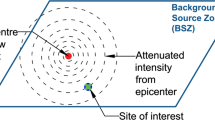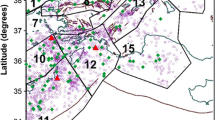Abstract
The occurrence of several recent “extreme” earthquakes with their significant loss of life and the apparent failure to have been prepared for such disasters has raised the question of whether such events are accounted for in modern seismic hazard analyses. In light of the great 2011 Tohoku-Oki earthquake, were the questions of “how big, how bad, and how often” addressed in probabilistic seismic hazard analyses (PSHA) in Japan, one of the most earthquake-prone but most earthquake-prepared countries in the world? The guidance on how to properly perform PSHAs exists but may not be followed for a whole range of reasons, not all technical. One of the major emphases of these guidelines is that it must be recognized that there are significant uncertainties in our knowledge of earthquake processes and these uncertainties need to be fully incorporated into PSHAs. If such uncertainties are properly accounted for in PSHA, extreme events can be accounted for more often than not. This is not to say that no surprises will occur. That is the nature of trying to characterize a natural process such as earthquake generation whose properties also have random (aleatory) uncertainties. It must be stressed that no PSHA is ever final because new information and data need to be continuously monitored and addressed, often requiring an updated PSHA.



Similar content being viewed by others
References
Bull WB, Pearthree PA (1988) Frequency and size of quaternary surface rupture of the Pitaycachi fault, northeastern Sonora, Mexico. Bull Seismol Soc Am 78:956–978
Cornell CA (1968) Engineering seismic risk analysis. Bull Seismol Soc Am 58:1583–1606
Geller RJ (2011) Shake-up time for Japanese seismology. Nature 472:407–409
Hanks TC, Beroza GC, Toda S (2012) Have recent earthquakes exposed flaws in or misunderstandings of probabilistic seismic hazard analysis? Seismol Res Lett 83:759–764
Kanamori H, McNally K (1982) Variable rupture mode of the subduction zone along the Ecuador-Colombia coast. Bull Seismol Soc Am 72:1241–1253
Mann P, Calais E, Demets C, Prentice CS, Wiggins-Grandison M (2008) Entiquillo-Plantain garden strike-slip fault zone: a major seismic hazard affecting Dominican Republic, Haiti and Jamaica: 18th Caribbean geological conference (http://www.ig.utexas.edu/jsf/18_cgg/Mann3.htm)
McGuire RK (2004) Seismic hazard and risk analysis. Earthquake Engineering Research Institute, Oakland
Minoura K, Imamura F, Sugawa D, Kono Y, Iwashita T (2001) The 869 Jogan tsunami deposit and recurrence interval of large-scale tsunami on the Pacific coast of northeast Japan. J Nat Disaster Sci 23:83–88
Monecke K, Finger W, Klarer D, Kongko W, McAdoo BG, Moore AL, Sudrajat SU (2008) A 1,000-year sediment record of tsunami recurrence in northern Sumatra. Nature 455:1232–1234
Nöggerath J, Geller RJ, Gusiakov VK (2012) Fukushima: the myth of safety, the reality of geoscience. Bull Atomic Sci 67:37–46
Petersen MD, Frankel AD, Harmsen SC, Mueller CS, Haller KM, Wheeler RL, Wesson RL, Zeng Y, Boyd OS, Perkins DM, Luco N, Field EH, Wills CJ, and Rukstales KS (2008) Documentation for the 2008 update of the United States National Seismic Hazard Maps. US Geological Survey Open-File Report 2008-1128, p 61
Satake K, Atwater BF (2007) Long-term perspectives on giant earthquakes and tsunamis at subduction zones. Earth Planet Sci 35:374–439
Senior Seismic Hazard Advisory Committee (SSHAC) (1997) Recommendations for probabilistic seismic hazard analysis: guidance on uncertainty and use of experts. US Nuclear Regulatory Commission, Vol 1, NUREG/CR-6372
Stein S, Geller RJ, Liu M (2011) Bad assumptions or bad luck: why earthquake hazard maps need objective testing. Seismol Res Lett 82:623–626
Stein S, Geller RJ, Liu M (2012) Why earthquake hazard maps often fail and what to do about it. Tectonophysics 562–563:1–25
Suter M (2008) Structural configuration of the Otates fault (Southern Basin and Range Province) and its rupture in the 3 May 1887 Mw 7.5 Sonora, Mexico, earthquake. Bull Seismol Soc Am 98:2879–2893
Taleb NN (2010) The Black Swan, Second Edition, The Impact of the Highly Improbable. Random House, New York
U.S. Committee on Large Dams (USCOLD) (1998) Updated guidelines for selecting parameters for dam projects. 2 appendices p 50
Acknowledgments
My thanks to Hans-Peter Plug, Stuart Marsh, and the ESF for their invitation to participate in the Conference on “Extreme Geohazards.” My appreciation to Melinda Lee for her assistance in the preparation of this paper, to Eliza Nemser and two anonymous reviewers for their reviews and to Editor-in-Chief T.S. Murty for his assistance.
Author information
Authors and Affiliations
Corresponding author
Rights and permissions
About this article
Cite this article
Wong, I.G. How big, how bad, how often: are extreme events accounted for in modern seismic hazard analyses?. Nat Hazards 72, 1299–1309 (2014). https://doi.org/10.1007/s11069-013-0598-x
Received:
Accepted:
Published:
Issue Date:
DOI: https://doi.org/10.1007/s11069-013-0598-x




